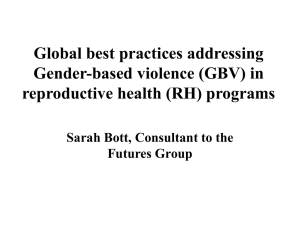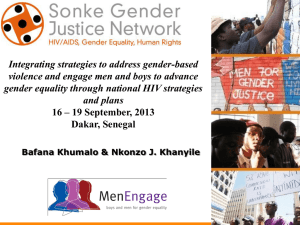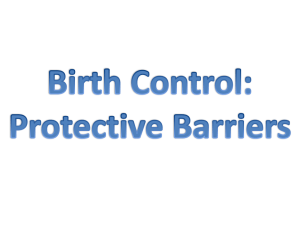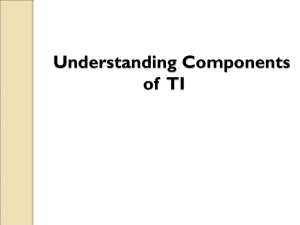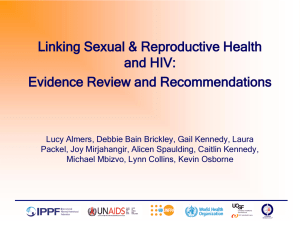PCB Thematic Session: SRH and HIV Linkages
advertisement
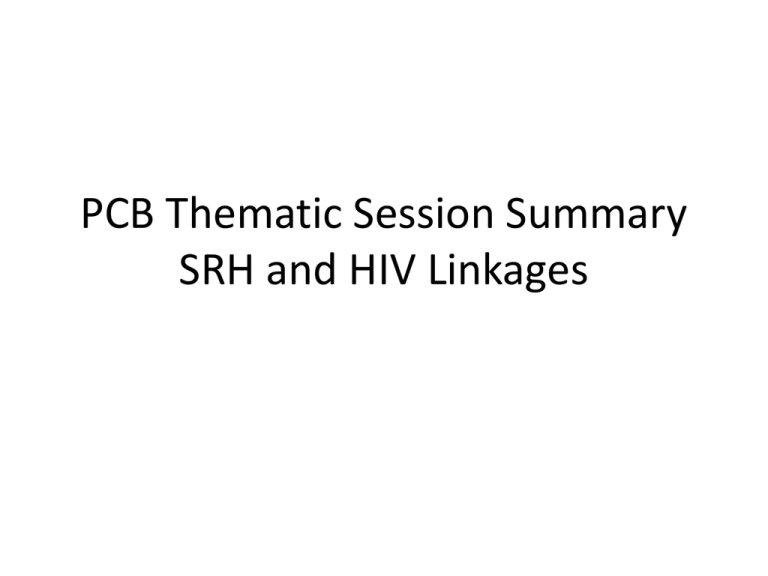
PCB Thematic Session Summary SRH and HIV Linkages Comprehensive Sexuality Education (CSE) • Lack of recognition of sexual and reproductive rights of young people • Legal barriers prevent young people accessing CSE and SRH/HIV services • “Political will is fundamental and it doesn’t cost anything” • Misinformation about what CSE is, its impact and importance CSE means: • • • • • Rights-base Age appropriate Gender transformative Evidence-informed Promotes self-esteem and empowerment • Biological aspects of puberty • Sexuality • Contraceptives • Options for unintended pregnancy • STIs/HIV • GBV • PLHIV • Skills for (avoid coercion, negotiate safe etc.) • Community/parents Integration of Services • Bi-directional service integration can work – no one model • Coordination mechanisms are essential • Human resources – training and retention (multitasking, task-shifting, attitudes…) & commodities “integration by default” • Understanding integration in low and concentrated epidemics • Tailoring services for people living with HIV, key populations, and young people • Services for and involving men • Reduction of stigma and discrimination What is being integrated? (Kenya) HIV/AIDS Services SRH Services VCT FP + (V) CT, ART, BCC, STI, Condoms ANC PMTCT, ART, BCC, FP, STI, TB + screening, Condoms STI, PMTCT …… Delivery + Post-Partum (V) CT, ART, BCC, FP, STI, + Condoms PAC/Abortion + (V) CT, ART, BCC, FP, STI, + FP, ART, BCC, STI, Condoms PMTCT + FP, ART, BCC, STI, Condoms ART BCC, STI, FP Condoms BCC + + FP, STI, VCT Condoms Condoms Post-rape + STI + (V) CT/PEP, ART, BCC, EC, Cervical Cancer screening Condoms + (V) CT, BCC, FP, Condoms Funding Opportunities for Integration • ‘Shift in the balance of power’ - country ownership for contextual solutions vs. restrictive/conditionalities of donors • “No such thing as a fully integrated or fully vertical system” – bottom line is comprehensive responsive to clients • Importance of global voices, especially around human rights, e.g. engagement principles • Funding driven artificial separation of SRH & HIV • “What we need most is integration of donors” “Integration is not itself an end but a means” to achieve… • • • • • Universal access goals Health outcomes Human rights Programme effectiveness/efficiency Link between community and health interventions • Elimination of stigma and discrimination GBV and HIV • GBV is an intrinsic human rights violation and intersects with HIV • Inclusive definition of what constitutes GBV (MSM/SW/TG/) • Stigma and discrimination, social exclusion and shame associated with GBV • Strengthen advocacy – influence (CSOs, FBOs, etc.) • Build capacity, to address the link between GBV and HIV especially in humanitarian settings • Need for more data collection and research • Multisectoral response legal reform, policy and programmatic (law enforcement (police, military), health, CSE, etc.) Support the integration of SRH and HIV services - sustainable financing, harmonized policies and good practice • • • • • • • No one model and integration is not a panacea Commitment by all relevant stakeholders Coordination mechanisms and inclusion of stakeholders Joint planning for harmonized approach “Movement in direction of success = put in more resources” Initially may be increased cost/allow time for change Human resources, training and retention of health professionals, (knowledge, attitudes & practices that uphold human rights). • Community and health systems strengthening Include relevant services and systems beyond the health sector • CSE - UNESCO’s International Technical Guidelines on Sexuality Education • CSE and YFS linked - requires MoH and MoE to work together • “Prevention revolution must include CSE” (e.g. LAC Ministerial Declaration “Educate to Prevent”) • Full implementation of the Agenda for Women and Girls • Health , psycho-social, judicial, law enforcement systems to address GBV and HIV Support collaborative action research to address key gaps • • • • • • • • Health outcomes Stigma reduction Cost-effectiveness GBV Men and boys Integration in low and concentrated epidemics SRH people living with HIV and key populations “If we wait for evidence to catch up we will constantly be reactive…” Strengthen ties between maternal, newborn & child health initiatives & HIV • • • • • • • • Favourable political enviornment Comprehensive 4-pronged PMTCT Maternal and child survival/virtual elimination HIV integrated into ANC, PP, FP, etc. Address stigma and discrimination Rights of people living with HIV Comprehensive universal SRH Low/concentrated epidemics Ensure linkages for key populations (including in low/concentrated epidemics) • Design and implement services need to do more to meet the needs of key populations (access, rights, etc.) • Direct funding to community based organizations, better at reaching and gaining trust of key populations • Advocacy to serve a broad constituency (universal access) • Engagement in policy making and programming • Legal/policy reform (e.g. end criminalisation) Remove punitive laws, policies, practices, stigma & discrimination that block access to integrated SRH and HIV services • Legal audit and law reform, access to legal services, programmes to reduce stigma and discrimination, know your rights/ law campaigns and training of key service providers • Non-discriminatory, inclusive, participatory, and accountable • “Doesn’t cost a lot being brave on these issues” • “Stand up for universality of human rights!”

